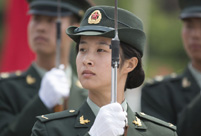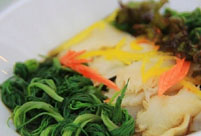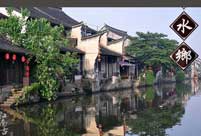 Chinese Kung Fu charms Silicon Valley
Chinese Kung Fu charms Silicon Valley
 Tranquil Yankou ancient town
Tranquil Yankou ancient town
 Lake Geneva: A show of swans
Lake Geneva: A show of swans
 Beautiful sunset over the Irtysh River
Beautiful sunset over the Irtysh River
 Qingjing Mosque: Witness of the ancient Maritime Silk Road
Qingjing Mosque: Witness of the ancient Maritime Silk Road
 Neiliansheng – more than 100 years of fashion
Neiliansheng – more than 100 years of fashion
 Golden retriever feeds baby African lions
Golden retriever feeds baby African lions
 Strange rocks in Lama Mountain
Strange rocks in Lama Mountain
 First overseas "China-standard" electric railway laid
First overseas "China-standard" electric railway laid
 College graduate launches organic agricultural cooperative in hometown
College graduate launches organic agricultural cooperative in hometownLocated on the Palmer Mountain to the west of the Potala Palace Square in Lhasa, the Temple of Guan Yu remotely faces the Potala Palace. The temple, by combining both the Tibetan and the Han elements, has become extraordinarily attractive in the city of mushrooming Tibetan Buddhist monasteries.
According to historical record, the Gurkha people from Nepal invaded and occupied the Nyalam and Gillon regions of the Tsang province in 1788. In the following year, the invaders were fought back into their own national territory by soldiers sent by the Qing Dynasty from the Chinese inner land. In 1791, the Gurkha people invaded Tibet again and marched straightly into Shigatse, ransacking everything they could lay hands on in the Tashilhunpo Monastery. This time, the Qing government specially appointed its great general Fu Kang’an and his army to defend the invaders. The Qing army joined the Tibetan people in shared hatred for the enemies and fought back together. In 1792, they defeated the Gurkha army and took all the lost treasure of the Tashilhunpo Monastery back. To memorize this great victory, the Qianlong Emperor and the VIII Dalai Lama authorized the regent Dacha Dunpaikumpot to build the Guan Yu Monastery in 1792, which is the current Temple of Guan Yu on the Palmer Mountain.
Since the shape of the mountain resembles a millstone, the temple is also known as the “Temple of Guan Yu on the Millstone Mountain”. Compared with other temples in Lhasa, this place appears extremely calm and quiet. It also beholds a wild profusion of high trees and glazed roof tiles that glitter in the sunshine. After entering the humble temple gate, one could climb up the winding steps with dark moss on the surface; go through an archway before arriving at the main hall of the Temple of Guan Yu – the hall of Guan Yu. From the architectural perspective, the temple was constructed in the post-and-lintel style with gable and hip roofs, which are characteristic of a classical Han architecture. There is also a 3-meter-high incense vessel with the engraved characters of “Temple of Guan Yu” on the surface, which is located at the front gate of the hall.
Entering the main hall, one will be braced by the solemn and valiant statue of Guan Yu in the front, while the four colored statues of Zhu Geliang, Zhang Fei, Guan Ping and Zhou Cang stood on the left and right side. The statue of Guan Yu is molded in a giant figure that animatedly holds a knife in his hand. The statue of Gesar, much worshipped by the Tibetan people, also stood on the left side of Guan Yu.
The yellow hall behind the main hall, called Kangar Lacan in Tibetan language, is the actual Manjusri Hall, which shares the architectural style of the Temple of Guan Yu. The hall enshrines the statue of the Manjusri Buddha, which is accompanied by the statues of the Tako Buddha, the four-armed Avalokitesvara Buddha, and the Nagarjuna Buddha on each side, among other clay Buddha figures of miscellaneous colors nearby.
There is also a square yard outside the main hall. The yard beholds a stone monument in the middle, which is about 3.04 meters high and 1.18 meters wide and consists of the three parts of the head, the body and the base. The head of the monument is sculpted into the shape of two playing dragons with four Chinese characters saying ‘immortality for thousands of years’ in the middle part. The front body of the monument is engraved with weaving cloudy and thunderous patterns, while the inscriptions are written in regular scripts. According to a lama named Kelsang at the temple, the inscriptions depict the historical battle of the Tibetan and Han people against the Gurkha people of Nepal.
Kelsang also said that since the establishment of the Temple of Guan Yu, the dual religious elements of loyalty and bravery as demonstrated by Guan Yu has made the figure the God of war and protection as widely accepted by the Tibetan people. Since then, Guan Yu has gained his own place in the shrine of Tibetan Buddhism and was soon included into both the Tibetan and folk religious systems, during which process the image of Guan Yu gradually evolved into the Casar King. Guan Yu is worshipped on May 13 (birthday of Guan Yu) each year. The worshipping ceremony, which gathers both the Han and Tibetan people, is the combination of the customs of both ethnicities.
Stroking the heavy monument now, I felt like hearing the cries and shouts of the Tibetan and Han army during the battle, the sensation is so real that I could even see their faces of religious piety. It then suddenly strikes me that this small temple of Guan Yu stands exact testimony to the harmony of different religious people here in the ancient city of Lhasa. Thanks to the central government which performed its territorial rights in Tibet, the Manchurian, Mongolian, Hui, Tibetan and Han people were able to join their efforts together in defense of the foreign invaders.
One thing to be sure is that with the long development of the cultural communication between the Han people and the Tibetan people, the faith in Guan Yu also spread to other parts of Tibet while being integrated into the Tibetan culture, during which process Guan Yu has evolved and been known as the Gesar King, and has also been integrated into the Tibetan Buddhist culture. The Temple of Guan Yu in Lhasa, by combining the Han and Tibetan elements, has become the historical relic that stands testimony to the joined battle of the two people against foreign invaders in safeguarding the sacred territory of our nation. This not only represents the determination of the Han and Tibetan people in preserving national unity, but also demonstrates the historical connection and communication between the Han and Tibetan people through religion and faith.
 Opening ceremony of 67th Cannes Film Festival
Opening ceremony of 67th Cannes Film Festival Pulse of Xiamen - Int'l Yoga art festival in May
Pulse of Xiamen - Int'l Yoga art festival in May Photo story: Life of a scrap metal recycle worker
Photo story: Life of a scrap metal recycle worker Training of the PLA's first female honor guard
Training of the PLA's first female honor guard China's 10 must-see animations
China's 10 must-see animations Female bodybuilders show their beauty of fitness
Female bodybuilders show their beauty of fitness A taste of Harbin cuisine
A taste of Harbin cuisine A bite of Jiang Nan
A bite of Jiang Nan Who is China's campus beauty queen?
Who is China's campus beauty queen? 8 great movies to watch with your mom
8 great movies to watch with your mom China's most luminous celebrities
China's most luminous celebrities Newly recruited police in Hetian hold drill
Newly recruited police in Hetian hold drill  Bird-men compete flying in Hong Kong
Bird-men compete flying in Hong Kong  The 'Chinese Dad'
The 'Chinese Dad' Shanghai locals bid farewell to childhood memories
Shanghai locals bid farewell to childhood memoriesDay|Week|Month